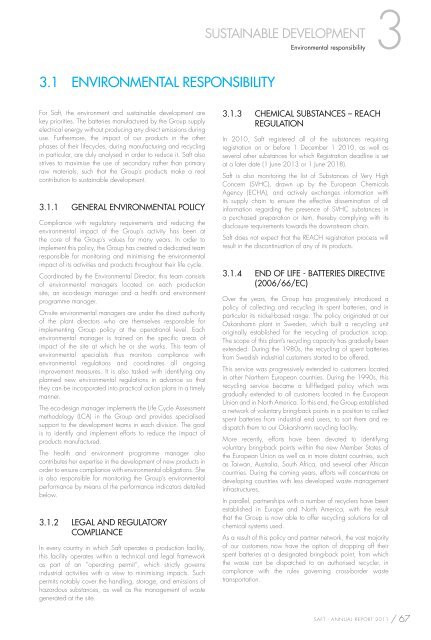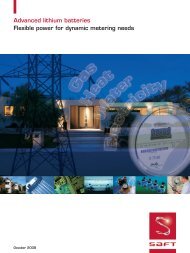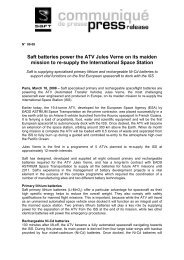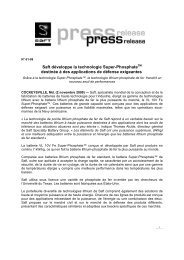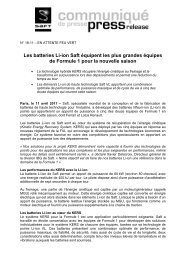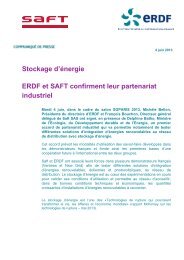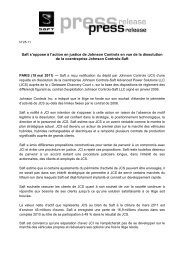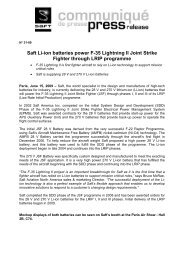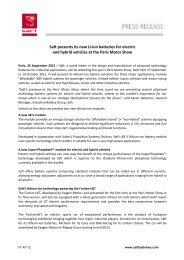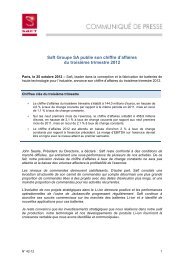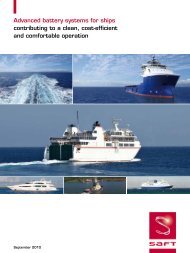ANNUAL REPORT 2011 REGISTRATION DOCUMENT - Saft
ANNUAL REPORT 2011 REGISTRATION DOCUMENT - Saft
ANNUAL REPORT 2011 REGISTRATION DOCUMENT - Saft
You also want an ePaper? Increase the reach of your titles
YUMPU automatically turns print PDFs into web optimized ePapers that Google loves.
3.1 ENVIRONMENTAL RESPONSIBILITY<br />
For <strong>Saft</strong>, the environment and sustainable development are<br />
key priorities. The batteries manufactured by the Group supply<br />
electrical energy without producing any direct emissions during<br />
use. Furthermore, the impact of our products in the other<br />
phases of their lifecycles, during manufacturing and recycling<br />
in particular, are duly analysed in order to reduce it. <strong>Saft</strong> also<br />
strives to maximise the use of secondary rather than primary<br />
raw materials, such that the Group’s products make a real<br />
contribution to sustainable development.<br />
3.1.1 GENERAL ENVIRONMENTAL POLICY<br />
Compliance with regulatory requirements and reducing the<br />
environmental impact of the Group’s activity has been at<br />
the core of the Group’s values for many years. In order to<br />
implement this policy, the Group has created a dedicated team<br />
responsible for monitoring and minimising the environmental<br />
impact of its activities and products throughout their life cycle.<br />
Coordinated by the Environmental Director, this team consists<br />
of environmental managers located on each production<br />
site, an eco-design manager and a health and environment<br />
programme manager.<br />
On-site environmental managers are under the direct authority<br />
of the plant directors who are themselves responsible for<br />
implementing Group policy at the operational level. Each<br />
environmental manager is trained on the specifi c areas of<br />
impact of the site at which he or she works. This team of<br />
environmental specialists thus monitors compliance with<br />
environmental regulations and coordinates all ongoing<br />
improvement measures. It is also tasked with identifying any<br />
planned new environmental regulations in advance so that<br />
they can be incorporated into practical action plans in a timely<br />
manner.<br />
The eco-design manager implements the Life Cycle Assessment<br />
methodology (LCA) in the Group and provides specialised<br />
support to the development teams in each division. The goal<br />
is to identify and implement efforts to reduce the impact of<br />
products manufactured.<br />
The health and environment programme manager also<br />
contributes her expertise in the development of new products in<br />
order to ensure compliance with environmental obligations. She<br />
is also responsible for monitoring the Group’s environmental<br />
performance by means of the performance indicators detailed<br />
below.<br />
3.1.2 LEGAL AND REGULATORY<br />
COMPLIANCE<br />
In every country in which <strong>Saft</strong> operates a production facility,<br />
this facility operates within a technical and legal framework<br />
as part of an “operating permit”, which strictly governs<br />
industrial activities with a view to minimising impacts. Such<br />
permits notably cover the handling, storage, and emissions of<br />
hazardous substances, as well as the management of waste<br />
generated at the site.<br />
3<br />
SUSTAINABLE DEVELOPMENT<br />
Environmental responsibility<br />
3.1.3 CHEMICAL SUBSTANCES – REACH<br />
REGULATION<br />
In 2010, <strong>Saft</strong> registered all of the substances requiring<br />
registration on or before 1 December 1 2010, as well as<br />
several other substances for which Registration deadline is set<br />
at a later date (1 June 2013 or 1 June 2018).<br />
<strong>Saft</strong> is also monitoring the list of Substances of Very High<br />
Concern (SVHC), drawn up by the European Chemicals<br />
Agency (ECHA), and actively exchanges information with<br />
its supply chain to ensure the effective dissemination of all<br />
information regarding the presence of SVHC substances in<br />
a purchased preparation or item, thereby complying with its<br />
disclosure requirements towards the downstream chain.<br />
<strong>Saft</strong> does not expect that the REACH registration process will<br />
result in the discontinuation of any of its products.<br />
3.1.4 END OF LIFE - BATTERIES DIRECTIVE<br />
(2006/66/EC)<br />
Over the years, the Group has progressively introduced a<br />
policy of collecting and recycling its spent batteries, and in<br />
particular its nickel-based range. The policy originated at our<br />
Oskarshamn plant in Sweden, which built a recycling unit<br />
originally established for the recycling of production scrap.<br />
The scope of this plant’s recycling capacity has gradually been<br />
extended. During the 1980s, the recycling of spent batteries<br />
from Swedish industrial customers started to be offered.<br />
This service was progressively extended to customers located<br />
in other Northern European countries. During the 1990s, this<br />
recycling service became a full-fl edged policy which was<br />
gradually extended to all customers located in the European<br />
Union and in North America. To this end, the Group established<br />
a network of voluntary bring-back points in a position to collect<br />
spent batteries from industrial end users, to sort them and redispatch<br />
them to our Oskarshamn recycling facility.<br />
More recently, efforts have been devoted to identifying<br />
voluntary bring-back points within the new Member States of<br />
the European Union as well as in more distant countries, such<br />
as Taiwan, Australia, South Africa, and several other African<br />
countries. During the coming years, efforts will concentrate on<br />
developing countries with less developed waste management<br />
infrastructures.<br />
In parallel, partnerships with a number of recyclers have been<br />
established in Europe and North America, with the result<br />
that the Group is now able to offer recycling solutions for all<br />
chemical systems used.<br />
As a result of this policy and partner network, the vast majority<br />
of our customers now have the option of dropping off their<br />
spent batteries at a designated bring-back point, from which<br />
the waste can be dispatched to an authorised recycler, in<br />
compliance with the rules governing cross-border waste<br />
transportation.<br />
SAFT - <strong>ANNUAL</strong> <strong>REPORT</strong> <strong>2011</strong> / 67


